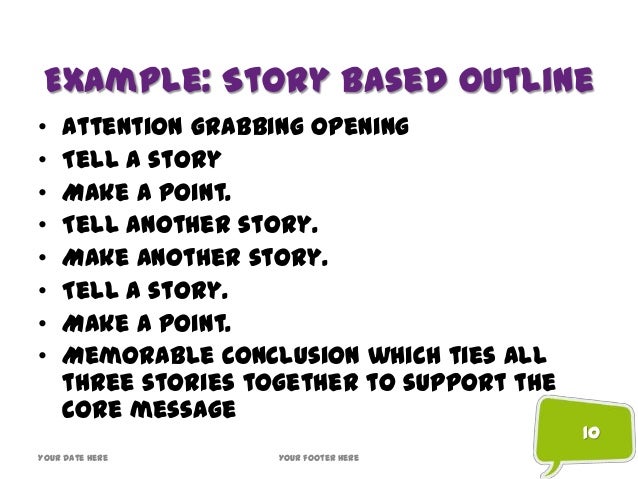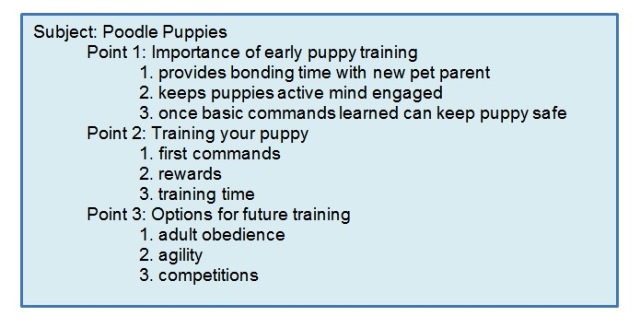
Feb 29, · The previous article in the Speech Preparation Series described how to select your speech topic and your core message.. This article describes how to support your core message with a speech outline, and provides numerous blogger.com is the second step in the six-step speech preparation process.. Writing an outline is, unfortunately, a step that many skip Step 2: Know who you are talking to Understanding your audience. Did you know a good speech is never written from the speaker's point of view? (If you need to know more about why check out this page on building rapport.)Begin with the most important idea/point on your outline. Consider HOW you can explain (show, tell) that to your audience in the most effective way for them to easily Oct 21, · You can, however, bring an index card with bullet points, just in case you freeze up. You shouldn't write your whole speech on the card, just the main points you hope to cover. Think of the card as a point of reference, rather than a backup for your speech
How to Write Dialogue: Formatting, Examples, & Tips
So, how do you develop a good speech outline? First, break it down into small steps as this will make it easier for you to prioritize your ideas and organize them in the right order before you add more details to them. Before you begin writing your outline, you should take a step back and think about your speech as a whole, how to write a speech from your point of view. First, think about the 3 keystones for your presentation or speech, i.
the audience, your subject matter and of course, you, as the speaker. Then, write a few notes down about each keystone and how they relate with each other. For instance. A good outline will help you engage with your audience in a way that not only captures their attention but enables them to understand the subject matter. This refers to the goal of your presentation.
Here, you should ask yourself, what do you want your audience to do after your presentation is over? While the objective for most speakers is for their audience to know something, that may not be enough. The best presentations and speeches are those that move people to act. If you would prefer to make an impact in such a way, then you should ensure that you are as specific as you can be when deciding on your objective in your speech outline. Your message is what holds your presentation or speech together, how to write a speech from your point of view.
Trying to include several different messages in your speech may confuse your audience, which makes it harder for them to understand the main point you are trying to convey. To do this, summarize the message of your presentation in one statement. This will not only allow you to understand the message in its entirety but also allow you to explain the message to your audience in a way that is easy to understand.
You can now use the statement you wrote above to help you develop your speech outline. When it comes to a presentation or speech, the audience should always come first. That is why as a speaker, you should always keep your audience in mind when presenting. If you have already decided on the message you will be conveying to your audience, you should now ask yourself; how is your message relevant to the audience?
This could mean that you will be presenting to the wrong audience or you will be giving the wrong presentation. This is a very important part of your presentation as without it, your speech will have no impact on the audience.
Therefore, you should ensure that you include the speech structure in your speech outline. A structure has 3 basic parts; the introduction, the body and the conclusion. It should be noted though that when working on your speech outline, a common suggestion is to begin with the body before developing both your introduction and conclusion.
To make a good first impression on your audience, ensure that your introduction is strong. Related: How to Start a Speech to Engage Your Audience. The body of your presentation represents the bulk of your speech, how to write a speech from your point of view. You should therefore ensure that your main points can be explained in detail and that they have been organized in a logical order that makes your message easy to comprehend. Similar to your introduction, you should finish on a strong note when it comes to your conclusion.
Below are a few examples of different speech outlines that you can use as a how to write a speech from your point of view to write your own outline. Choosing the right one that works for you may depend on the type of speech you will be giving.
Persuasive presentations and speeches usually have a specific purpose in mind; either to urge the audience to take action on something or persuade them to adopt a certain view or opinion of something. This type of outline allows you, the speaker, to focus on the subject matter point while arguing your case in the most effective and compelling way to your audience.
The first three parts are common in most if not all presentations; please refer to step e to familiarize yourself with them once more. A source citation is simply citing the sources for the research and facts that you presented in your speech.
Remember you are trying to how to write a speech from your point of view your audience, so authoritative sources add weight to your argument. These outlines are made up of 3 basic parts; the introduction, body and conclusion. How to write a speech from your point of view purposes of this article, we will be discussing the informative speech outline.
The central objective of an informative speech is to offer unique, useful and interesting information to your audience.
Before choosing your informative speech topic, you should consider your overall objective. In addition to this, there are patterns that can be used to organize your speech outline. These will be chosen depending on your speech type. Furthermore, there are 2 possibilities for preparing a speech outline; the speaking and how to write a speech from your point of view outline.
The speaking outlines make use of phrases and keywords, which helps keep you focused on the subject matter while the preparation outline is used to help you develop your speech and makes use of full sentences. A demonstrative speech is an instructional speech that teaches the audience something by demonstrating the process. For a more in-depth guide on writing demonstrative speeches, click here.
Pro-Tip: Write down the specific purpose of your speech and your topic of discussion as you formulate your generic speech outline. Rather, situations often make it necessary to mix different formats. However, without a good speech outline, your speech lacks the proper skeleton to put meat on. A speech outline is to a speech what a blueprint is to an unconstructed building.
Table of Contents. How to Make an Outline for a Speech. a What is the big picture? b What is your objective? c What is your message?
d How is your presentation relevant? e Your speech structure. Different Speech Outline Examples. Persuasive Speech Outline. Informative Speech Outline. Demonstrative Speech Outline. Conclusion: On Speech Outline Formats. Below are steps that will enable you to write an effective speech outline for your presentation.
You should start by asking yourself:. You can refer back to step c then review steps a and b for clarity. e Your speech structure This is a very important part of your presentation as without it, your speech will have no impact on the audience. Related: How to Start a Speech to Engage Your Audience The body of your presentation represents the bulk of your speech. Different Speech Outline Examples Below are a few examples of different speech outlines that you can use as a basis to write your own outline.
Persuasive Speech Outline Persuasive presentations and speeches usually have a specific purpose in mind; either to urge the audience to take action on something or persuade them to adopt a certain view or opinion of something.
A persuasive speech outline is made up of these parts: An introduction The body The conclusion Source Citation The first three parts are common in most if not all presentations; please refer to step e to familiarize yourself with them once more. Informative Speech Outline There are different types of informative outlines.
These include: The informative speech outline The informative presentation outline The informative essay outline These outlines are made up of 3 basic parts; the introduction, body and conclusion. Additionally, there are various types of informative speeches, including:. Types of these patterns include:. Demonstrative Speech Outline A demonstrative speech is an instructional speech that teaches the audience something by demonstrating the process, how to write a speech from your point of view.
What are you waiting for? Go out there and grow your confidence as a speech writer and speaker!
How to structure a speech
, time: 5:39How to Write an Informative Speech: 14 Steps (with Pictures)

Feb 01, · Pro-Tip: Write down the specific purpose of your speech and your topic of discussion as you formulate your generic speech outline. Conclusion: On Speech Outline Formats. As you become better at writing and delivering speeches, you will soon learn that the different outline formats described above aren’t mutually exclusive Feb 29, · The previous article in the Speech Preparation Series described how to select your speech topic and your core message.. This article describes how to support your core message with a speech outline, and provides numerous blogger.com is the second step in the six-step speech preparation process.. Writing an outline is, unfortunately, a step that many skip Step 2: Know who you are talking to Understanding your audience. Did you know a good speech is never written from the speaker's point of view? (If you need to know more about why check out this page on building rapport.)Begin with the most important idea/point on your outline. Consider HOW you can explain (show, tell) that to your audience in the most effective way for them to easily
No comments:
Post a Comment